HEKATE
Research for www.ilcerchiodellaluna.it
Translation by Katiuscia Cancedda translatethis1@yahoo.co.uk |

Vai alla versione italiana |
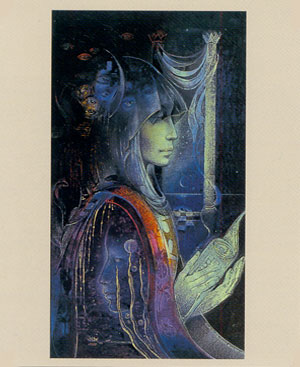
Hekate the young and the elder, Hekate the psyche explorer, midwife and escort for the dead, Hekate Goddess of crossroads, Hekate the powerful and the wise, Hekate trivium, Hekate the manifold. It’s not easy to talk or write about Hekate, her universe too vast. We waited a long time before deciding to edit a research on Her… we waited for Her, maybe feared Her… and then we received the sign we were waiting for (a research sent to us by a reader, whom we publicly thank). And so, like a ripen fruit, our work followed, culminating on the meditation to meet with Her.
We tried to mention each single aspect about her in this research, conscious that this space cannot certainly deplete a myth like hers. We particularly like to emphasise her origins as midwife and her value as wise and elder, allowing ourselves to explore a theme we always wanted to: the encounter with menopause, the age of a woman’s real power.
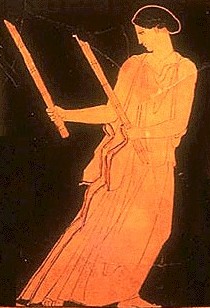  “I celebrate Hekate trivia, amiable protector of roads, “I celebrate Hekate trivia, amiable protector of roads,
arthly and marine and celestial, with her crocus coloured cloak,
Sepulchral, dionisiac with the souls of the dead,
Daughter of Crio, lover of the superb solitude of stags,
Nocturnal protector of dogs, invincible queen,
Announced by beasts’ roar, unbeatable without girdle,
Bulls’ tamer, lady that keeps the keys of Cosmos,
Mountains haunt, guide, nymph, youngsters’ nurse,
Nurse of the maid that begs to attend sacred rituals,
Kind toward her devotee, always with joyful spirit”. (1)
In his Theogony, Hesiod dedicated this hymn to Hekate, where Zeus confers glory and supreme power on Earth, Underworld and Heavens to the Goddess, granting her at the same time the original rights as descendant of primordial deities, among which the right to allow or refuse to mortals anything they wished for:
“Whom among all Zeus Chronide honoured, and gave illustrious gifts to her,
To have power above the earth and on the sterile sea;
She also has her own honourable part on the starry sky,
And she is supremely honoured by the immortal Gods”.
It is to Hekate that Demeter asks, in her desperate search for Persephone, for information to find her daughter. (2)
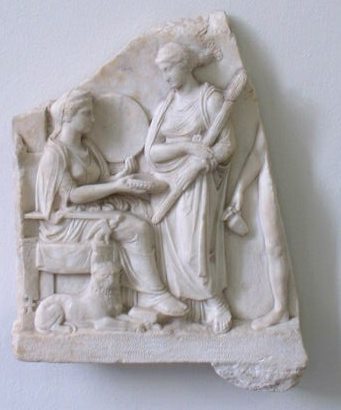 “But none among immortals or mortals “But none among immortals or mortals
Heard her voice, nor olive trees with their splendid fruits.
Only Perses’ daughter, who has a candid mind,
Hekate, with the luminous diadem, in her antrum,
And the divine Helios, Hyperion’s splendid son,
Heard the maid invoking her father Chronide; …”
And again:
“… But when finally dawn came for the tenth time,
Hekate met her, holding a torch in one hand;
And, wishing to inform her, she spoke, saying:
Venerable Demeter, bearer of crops, with magnificent gifts,
Who was among celestial gods and human mortals,
Who kidnapped Persephone and threw your heart in anguish?
In fact, I heard screaming but didn’t see it with my eyes
Who was the kidnapper: I told you everything, briefly and sincerely’.
So Hekate spoke; and Rea’s daughter with her beautiful hair
didn’t reply to her; rapidly, instead, she moved with her,
clasping burning torches in her hands…”
However, if quotations referring to her are rare, a very entrenched cult was dedicated to the ancient and mysterious Goddess that, starting in the East, survived to the indo-European and Greek cultures, arriving to the modern era in several variants.
The Name
The most spread etymology of Hekate’s name derives from the equivalent feminine name of Hekatos, a dark epithet of Apollo (Hekate and Apollo were often combined in oracular places). It was translated in various ways, such as “the one that strikes, that operates from a distance”.
According to others, the name derives from the Greek term for “wish, wanting”, with reference to her power of accomplishing mortals desires.
To many others her name could come from the same root of the word “hundred”, referring to the many forms she can take: Hekate, descendant from the Titans, the manifold.
Among the Mediterranean goddesses, the similarity between Hekate’s name with the one of the Greek goddess-midwife Heqit, Heket or Hekat may attract attention. The elder was the tribal matriarch of pre-dynastic Egypt and was known as the wise woman. Heket was a goddess with a frog-like head connected to the embryonic state, in which the dead seed decomposes and starts germinating. She was also one of the midwives who assist every day to the birth of the Sun. All these analogies with Hekate, beyond the name, could suggest a common original archetype.
Finally, Heka was the term indicating magic among the Greeks (there was a divinity called Heka, often represented as a combination of deities) linked to the term ka, or vital energy, soul or spirit, therefore heka literally meant “to activate the ka”.
The Origins
Ancient deity linked to fertility and life cycle, Hekate enters the Greek world and is described as one of the Titans, although her origins were antecedent to the Olympic Pantheon. She lived before the three waves of invasions by Ions, Achaeans and Doreans, therefore she took place amongst pre-Hellenic deities like Aphrodite, Artemis, Athena/Metis, Demeter, Persephone, Gaia, Eris, Rea, etc. The most ancient tradition refers to her as a pre-Olympic divinity, as the daughter of Erebo and Night. Until her connection with fecundity was obscured, she was said to be the mother to Circe and the Three Graces.
Hesiod describes her as Goddess of Stars, daughter of the virgin (starry) mother Asteria and destined to inherit the throne as Goddess of the Skies. Asteria was one of Letho’s sisters who gave birth to Apollo and Artemis, making Hekate Artemis’ cousin.
To confirm the high consideration that Greeks had for this Goddess’ former origins, she was recognised a power possessed by Zeus: to grant or forbid the accomplishment of humanity’s desires.
Indeed, the documentation concerning her is scarce and the interactions she had with other deities within the Greek mythology are poor, which could validate the theory about her very ancient origins.
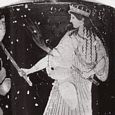
Traditional iconography
The first representations of Hekate are as single and not as threefold, while she was connected to crossroads and trivia since ancient times. Pausanias maintained that Hekate was painted in threefold form for the first time by the sculptor Alkamenes during the Greek classic period, toward the end of the fifth century. Others carried on presenting her in single form, often holding one or two torches.
She was described as a creature with three heads on Greek esoteric books of Egyptian origin, with reference to Hermes Trismegistus, and on magic papyruses in Late Antiquity: one head of dog, one of snake and one of horse.
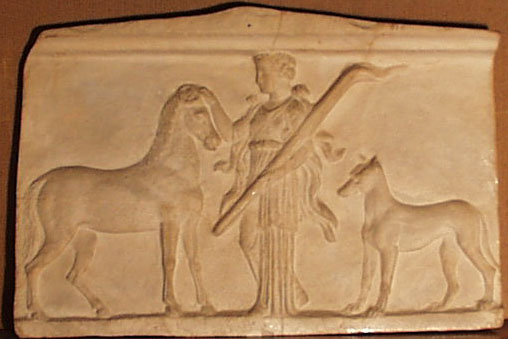  A marble image of the fourth century A.C. by Crannone in Tessaglia showed Hekate with a dog while she rests a wreath on a mare’s head. A marble image of the fourth century A.C. by Crannone in Tessaglia showed Hekate with a dog while she rests a wreath on a mare’s head.
The female dog is her companion and equivalent animal, and one of the most usual offering to Hekate was leaving meat at crossroads.
Often dogs were sacrificed to her (a right reference to her non-Hellenic origins, since dogs, as well as donkeys, were rarely taken in high consideration by the ancient Greek rituals). (4)
In the Orphic hymn quoted in the opening, she is described “without girdle”, with loose clothing.
Appellatives
Chthonia = belonging to the Underworld
Antaia = She whom encounters
Apotropaia = Protector
Enodia = the Goddess who appears on the way
Kourotrophos = children’s Nurse
Propulaia/Propylaia = She whom stands on in front of the door
Propolos = She whom serves
Phosphoros = Bearer of Light
Soteira = the Sage
Triodia/Trioditis = that frequents crossroads
Kleidouchos = that bears the keys
Trimorphe = Threefold
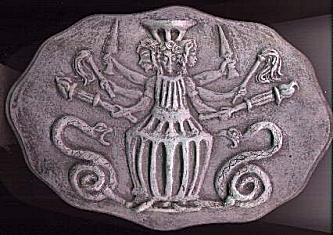  Hekate’s symbols
Hekate’s symbols
Hekate guards and supervises crossroads: any crossroad, particularly the one in which three roads cross, is sacred to her, and newsstands and effigies were built in her honour long time ago. Many peasantry originated beliefs and rituals land on crossroads and trivia in their culminating phase and offering are taken to these places in her honour. Placed on three road crossings, Hekate’s statues would protect wayfarers, helping them choosing the right journey and identifying less risky ways, hence why she has three heads in some of her representations, each head looking to a different direction. Christianity, instead, turned these places into diabolic territories were those who committed suicide were buried. C Conversely, crossroads are places in which energies concentrate: roads, paths and destinies, all cross and lead to a choice. Hekate is the Goddess of choices and of freedom to choose.
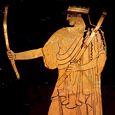 The flambeau (torch) is said to be one of Hekate’s fundamental attributes, light that illuminates darkness, divine wisdom, divine essence of light. Hekate’s flambeau is used to illuminate souls in their passage between light and darkness, but also to light up the sparkle of life to help it leave darkness. The couple Apollo-Hekate, in many oracular sites (eg. Sybil of Cumae) also talks about the two-faced wisdom light: the Apollonian day light and the inner light of nocturnal Hekate. The flambeau (torch) is said to be one of Hekate’s fundamental attributes, light that illuminates darkness, divine wisdom, divine essence of light. Hekate’s flambeau is used to illuminate souls in their passage between light and darkness, but also to light up the sparkle of life to help it leave darkness. The couple Apollo-Hekate, in many oracular sites (eg. Sybil of Cumae) also talks about the two-faced wisdom light: the Apollonian day light and the inner light of nocturnal Hekate.
The dagger appears in many representations of Hekate, maybe associated to her role as nurse (to cut the umbilical cord), but it’s also related to her role as guide in death, with which she cuts the connections between the physical body and the spirit.
The key is a significant attribute of Hekate as guardian of thresholds. Hekate Kleidoukoz (or Kleidoukos) is “She whom bears the key” to control the passage from the surface world to the chthonic world of Hades, from the known to the unknown realm. Hekate, Persephone’s guide to the Underworld, is also the keeper of mysteries, the priestess who transmits the secrets of knowledge.

 The snake belongs to the animal kingdom and is associated to the concept of the maze. The snake is the animal emerging from the chthonic world, connected to regeneration through the shedding of its skin. The snake belongs to the animal kingdom and is associated to the concept of the maze. The snake is the animal emerging from the chthonic world, connected to regeneration through the shedding of its skin.
In the so-called Chaldean Oracle, edited in Alexandria, the Goddess was linked to the symbol known as Wheel of Hekate, with serpentine forms drawing a labyrinth with three directions. Trinity - life, death and re-birth, regeneration and other meanings are encased in this symbol.
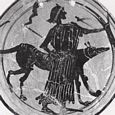
The dog is instead a symbol of the afterlife, ancient lead for the dead. Hekate’s presence or apparitions at crossroads manifested through distant dogs barking. She also shares numerous symbols linked to the figure of Cerberus (Kerberos), keeper of Hades.
Other animals symbolising Hekate are horses and black cats. The owl is her messenger; her carriage is hauled by dragons.
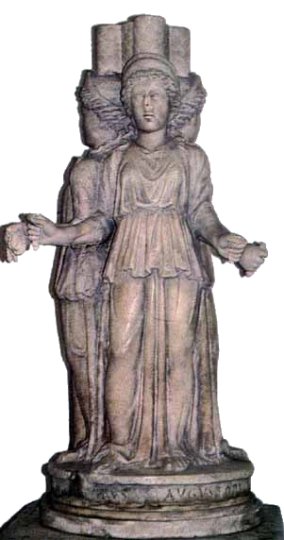  Single and threefold
Single and threefold
Hekate’s myth and associated symbolism are very complex. She’s single and threefold together since she assembles the three aspects in herself, aspects that are seen by some contemporaries as the one of the maid, the mother and the elder woman (from which the Latin term trivia derives).
For the ancient Greeks, feminine deities associated to the Moon were fundamentally three: Selene (the Full Moon), Artemis (the New Moon) and Hekate (the Waning Moon), later recovered by the Roman civilization under the names of Luna, Diana and Hekate. She’s supposed to be representing one of the three aspects of Mother Earth, Demeter, including also the virgin Persephone and the wise Hekate, the final stage of a woman’s growth.
In virtue of her threefold nature, she’s seen also as the Goddess of Time and Destiny, congenial to the Parches and the Moires, for her ability to look into the past, present and future. She also seems belonging to three worlds, being able to freely cross the Underworld, the world of immortals and the world of Deities.
The Latin writer Ovidius quotes her like this in “Fasti”:
“… Hekate’s faces turn toward the three parts / because she watches crossroads dividing themselves into roads…” Presiding three road crossings, moreover, may suggest a physiologic reality: it is similar to how the human nervous system works, with its triple internal intersections.
Her powers
As seen already in her name, Hekate is deeply connected to the idea of power, magical power. Power words (or incantations) are connected to Hekate: the Egyptian term “heka”, what activates the ka, indicates the act of voicing intent, so that the effects manifest immediately as soon as it’s left the lips of who is expressing it, the magic of will that expresses itself and creates.
Despite her rare apparitions within the Olympus, Hekate maintained her authority on heaven, earth and underworld, as well as her role of keeper of wealth and life blessings. As seen, Zeus himself didn’t dare dismissing her, although Hekate’s power remained as greater as his, if not more. On the contrary, he honoured her to the point in which he allowed her the ancient power of granting or neglecting to mortals their desires.
Among her attributes we also acknowledge her omniscience, for she knows past present and future of anyone, and symbolises the connection of past lives and lives to come in virtue of that. She is represented in fact with a book in one hand and a torch in the other, indicating her deep knowledge and wisdom, and her role as guide in darkness.
Consequently to her association with Persephone, and to her origins as Heket, the Egyptian midwife Goddess (more on her below) is connected to the concept of death and regeneration. It is her task to accompany the souls to the underworld, but she also takes the same journey on reverse, that is bringing from death to life and illuminating the path in darkness since birth; she therefore represents the courage to venture where we don’t know the way, the courage to go beyond our limits.
Hence Hekate is the connection between the world of the living and the world of the dead that unites darkness and light. Darkness is also everything that is unknown to us, the unconscious, all that is hidden but present in our life. Hekate is the torch that sheds light in this boundless kingdom that often we deny, or maybe we don’t recognise to have in ourselves. Her purpose is that of guide, illumination and freedom. In this sense, she’s equal to Virgil: as a wise chaperone, her task is to point the way to the underworld, to light it up, releasing the way to whomever she’s accompanying.
Hekate is also an expert in the arts of divination. She donates dreams and visions to humans which, if wisely interpreted, lead to greater clarity. As already mentioned, she was one of the goddesses linked to the oracles of the Sybils.
Waning Moon
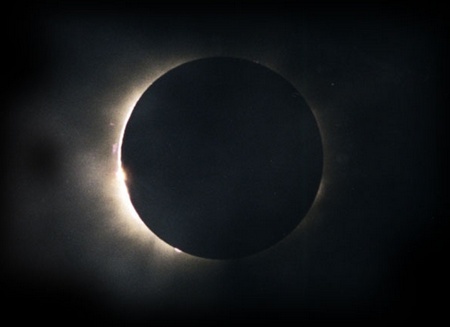 Seen as representing the waning moon, Hekate reminds us of a woman’s age coinciding with menopause and post-menopause, a time that holds the maid and the mother without carrying obligations belonging to them, but only the gifts. Contrary to what’s commonly thought about the female elderly, this is a life phase characterised by wisdom, introspective ability, but also independence, and creative and sexual power.
Seen as representing the waning moon, Hekate reminds us of a woman’s age coinciding with menopause and post-menopause, a time that holds the maid and the mother without carrying obligations belonging to them, but only the gifts. Contrary to what’s commonly thought about the female elderly, this is a life phase characterised by wisdom, introspective ability, but also independence, and creative and sexual power.
The female elderly is a factor of change and transformation, since having lived life fully allows her to
indulge in darkness and transformation, accepting the mystery of death.
This is Hekate, or Baba Yaga, or the Spider Woman Grandmother, or the Morrighan, and many more
ancient goddesses representing that phase of life in which it is possible, being freed at last from the
productive pace of youth, to develop the magic side, finally letting the shaman, the remedy woman or the rural healer emerge.
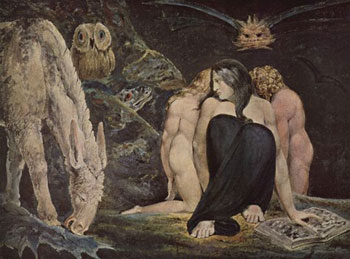  The Goddess of shadows
The Goddess of shadows
According to the myth, Hekate is related and ancestor to Circe whom is the same to Medea: three generations of witches representing the ambivalent aspects of the dark feminine, from the knowledge of the mystery of life to magic that manipulates and forces, animated by the desire of power and vengeance.
Knowing the laws of the shadows’ world, Hekate, Circe and Medea also incarnate the archetype of First Woman, of the Great Goddess to whom one would refer with faith but, more often, with fear, for she could give or take away life.
Christian Gnostics attributed this terrifying aura to threefold Hekate, with her winding hair, while Neo-Platonists located her in the third level of the female demoniac hierarchy with twenty seven demons under her orders, just as many as the days in the lunar month.
Goddess of crossroads, Goddess with many names, she was the detaining goddess of all magical signs.
Threefold Hekate was honoured with a three masks simulacrum with monthly rituals of purification called “Hekate’s banquets” in which dog’s meat and eggs were symbolically served: through the eggs, according to the tradition, would pass all impurities that could be eliminated in Hekate’s womb as deity of the powers of the underworld.
It was said that the terrible Hekate would wander at night with her ferocious dogs taking wayfarers off road after shocking encounters with demons living in the so-called “Hekate’s alcove”; this was a deep concavity on the Moon in which, according to Plutarch (Plutarchos), souls would pay the price for their sins before dying and turning into demons, though not always acting as malignant spirits, but becoming effective help for the living. To Plutarch, Hekate is the Queen of Demons and Ghosts, bringing about death, destruction and terror.
Nevertheless, as Goddess of the Night, she also possessed the gift of magic, of sympathy e of inspiration by sending “nocturnal visions”. In fact, as Queen of the Underworld, she owned everything that hides in the psyche and in the unconscious.
Hekate was originally considered the symbol of the primal tripartite of the year in three seasons, with her three dogs’ heads, before taking on a dark aura, after still bearing the “hidden diadem” and the “candid mind” in Homer’s time.
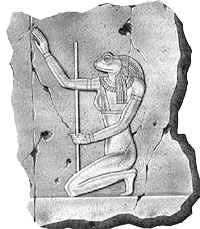 Heket the midwife, the Goddess frog Heket the midwife, the Goddess frog
Heqet or Heket, the Egyptian midwife Goddess is one of the origins of Hekate. Heket, midwife goddess through her totem, and Hekate, keeper of the gateway between life and death, also refer to our ability to change.
These figures invite us to create a radically new life starting from the body of the previous life, placing itself to the point of transition between a state and another. The Egyptian Heket, frog goddess, connects to the primordial elements of human life: she is amphibian, damp, vulnerable. She’s a genetic creator that supervises the mysteries and rites pertinent to birth, death and re-birth; from her open legs flow pearls of life.
The archaeologist Marija Gimbutas described, in her studies, traces and artefacts directing to a devotion of the frog goddess lasting 10,000 years circa: “The powers of the goddess of death and regeneration incarnated in her, her tasks being those of accompanying to death and re-establishing life.”
Women’s protector and midwife at the birth of all five great deities of the Osiris’ Pantheon, Heket stands at the threshold of transformation. Incarnation and liberation cycles, the procession of births, deaths and rebirths were her competence. In numerous archaeological sites in Greece, Rome and in Hellenised Egypt, terracotta lamps were found painted with the frog seal carrying the inscription “I am resurrection”. Amulets in the form of a frog often were placed on corpses to transfer the power of rebirth on to them. Later, Christian Copt tombs carried the incision of a frog next to a cross. Linguistic connections link Heket to the aspect of God’s wisdom (Chokmah) in the cabalistic tree of life. The Gnostics called this aspect ‘Sofia’ or ‘Hagia Sofia’ (hagia = saint, sacred).
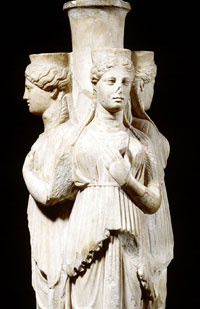  Hekate, the ancient Goddess and patriarchate
Hekate, the ancient Goddess and patriarchate
Before the coming of Zeus and the Olympics to symbolise the prevalence of a warrior-patriarchal society on matriarchate, Hekate was considerate a positive divinity for regeneration but with time, unfortunately, the common thought preferred to underline her destructive power rather than her creative force. Hekate was then represented more or less young and beautiful, as much as the other goddesses.
The triple Goddess with supreme powers was confined little by little to the realm of shadows and sorcery, turned into an old hag and venerated almost exclusively by the feared “Thessalian Witches”.
As mentioned before, besides Zeus, she alone was recognised the power of granting or forbidding the fulfilment of desires to humanity and to regulate the birth of men, animals and plants, like the Luna-Goddess. A very important role that with time, though, was reconsidered: could such a great power on Nature held by a female deity possibly cast a shadow on an already prevailing patriarchate both in the human society and, as a reflection, in the Olympus?
This historic action started in ancient Greece, continued in Rome and was then perfected by the institutionalised Christianity, meaning to transform the primordial woman-Goddess into an infernal entity. By then, the Goddess looking more mysterious than the Moon, the veiled one that conceals herself to die and be born again to light, had become the Queen of Witches in the common idea, she who prepared lethal potions inside the copper cauldron which, in reality, represents a distant memory of the archaic maternal bowl of fecundity and rebirth. The Crone Moon, symbolised by the wise and powerful Hekate, was turned into an old hag dressed in black, with a black hat, emblem of her gloomy nocturnal aspect, and riding a broom.
Maria di Rienzo writes: “At symbolic level, the river’s currents dragged her even farther than what she had been. Among the three kingdoms, the underworld was left to her, where she became the obscure and supremely malevolent mistress of the night. Debased and cursed, only accompanied by owls and black dogs, she inspired any wickedness and blasphemy. Inquisition officers used to mention her to the tortured as the one belonging to the legions of Evil.
Hekate’s story tells us something about the development of our own collective history as human beings, something bitter and quite frequent. Maybe we should learn again to understand her, this initiator and midwife situated at the crossroads of the soul.
If I try to depict her in my mind, I can see a woman that waves to go towards her. She prompts me to take the entire harvest I can claim from myself, to go beyond what I perceive as boundary and that indeed is the wall of a cage that I, myself, have contributed to build up.
She asks me to recognise the primordial and the advanced, the beginning and the end, the light and the darkness, and to relate them to each other. She asks me to heal and to become a whole. She puts me in front of my human and native ability to transform. She reminds me that I can evoke powers of creation that lay intact in me, by the word hekau.
It is time to set out on a new vessel, says Hekate to human beings. It is time to leave the chrysalis and enter a new intimacy, a new vulnerability. To open up, learn, go. Metamorphosis. There’s nothing to be afraid of: Hekate is a midwife, and she only wishes to help us be born”. (6)
Hekate, the witches and Epiphany
With reference to the broom, let’s remind ourselves that Hekate is the goddess of black poplars and willows: in Northern Europe, the link to the willow and the witches is so tight that the word witch derives from the same name referring to the willow in ancient times, from which wicker derives; in fact, the broom of British witches is traditionally made with woven to honour Hekate.
The great Mediterranean Lunar Mother, Trivia Mother for the Celts, became a terrible termagant, the old Devil’s Grandmother, the same that in popular Germanic tradition of Celtic origin takes on different names: the “Grandmother”, Grossmutter, verbal contraction of Grosse Mutter (“Great Mother”); or, in Northern Germany, the Frau Holde, an ugly evil witch that, at night between Christmas and the Epiphany, wanders around with a crowd of boisterous demons; or again, in Southern Germany, Frau Bertha (from berth = bright, shiny), an elderly woman bearing gifts on the night of the Epiphany. The Queen of Witches and the kind Hekate, whom in Hesiod’s Theogony “… large favour and help grants to those she wants… nurse to the young faithful to her…”, have joined to create the popular Epiphany (Befana) as well as the Germanic Frau Bertha, dispenser of presents for the good children (“the young faithful to her”) riding a broom on the night of the Epiphany.
Rites to honour Hekate
In ancient Greece, the most important festivals to honour Hekate were celebrated on August the 13th and November the 30th, in summer time and in winter time, probably in the middle of the night, generally at one of those crossroads chaired by Her. Fires were lit up and the Goddess was celebrated with a banquet. The 16th of November was also dedicated to Her: on that occasion, food offerings were taken to crossroads. Other sacred times devoted to Hekate were New Moon nights.
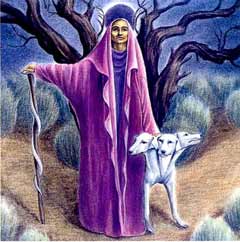 A rite to Hekate: the time of Menopause
A rite to Hekate: the time of Menopause
Hekate accompanies us in many passages of life, but the value as guide to the underworld and as midwife for a new rebirth lends itself to women in particular as a reference for the significant time of menopause.
At the menarche, the woman enters her own power,
With menstruations, she practises her power,
In menopause, she becomes her power.
A Native American saying
The passage to menopause, as all passages of life, commits us to a rebirth that goes through
death and bereavement, taking us to a journey in that liminal zone where Hekate reigns and illuminates: the middle time, that which no longer is but which isn’t yet.
You can choose to celebrate this rite in this middle time, when we dwell the threshold zone,
or when the menopause is reached, as sanction of occurred passage, a new time, a new started life.
In the first case, we can ask Hekate to guide us toward transformation, to succeed in processing our power, to crystallise what we’ve learned, to become aware of the last cycles, gradually leaving those aspects in which we used to live. We can ask Her to take us to the dwelling of our deepest inwardness and guide us toward our central balance in which we can spend even longer time.
At this time in which fluctuations seem amplified at times, we can ask Hekate to illuminate the way at the crossing of energies that go through us, helping us reading through the new and the old that meet up in us and recognising aspects of our power in motion. This could be a personal ritual, to be repeated at every lunation, in which we could foresee a time for separation (what we’re leaving), for the pain accompanying bereavement, and a time for meditation, for grounding and internal listening under Hekate’s aegis.
In the second case, we can acknowledge the walked path through Hekate, honour the acquired wisdom, celebrate the “change of level”, our new role of reference, of source of wisdom for the world. We can also celebrate a new “lightness” (did you notice how the elderly turn even lighter, even physically?), a phase in which some responsibilities slip away from our life, maybe our commitment to the world can lessen, finally leaving us time to dedicate to our authentic interests.
A time for celebration is indicated for this rite, maybe a banquet, surrounded by our contemporary female friends that can share the meaning and, if you wish, even women of different ages, as witnesses of our present. Even in this case, for the passage to be complete, it’s essential for it to be a time that allows what no longer is: you can choose whatever way you prefer to bury what no longer belongs to you.
In both cases, it’s a rite to be prepared calmly and with inner concentration, choosing the place and time according to your inwardness, without asking for external advice, but simply communicating your choices to those you want once you feel that they’ve stabilised. This is also the reason why indications to these rituals are deliberately open and we do not offer practical and specific readings, as instead we do for other Goddesses on the web site.
Hekate as Lunar Goddess also reminds us that the time of menopause isn’t a time literally ‘fixed and permanent’. If our personal oscillation, our menstrual cycle is finished, this will only bring us more in touch with further extensive cycles, the one of the moon, of seasons, of the world and of others. We open to a vaster belonging; we can grow more sensible to the breath of the earth, to lunar phases, to the vast energy in which all life, interconnected, communicates. Obviously, it won’t be a time lacking oscillations. Life is cycle and oscillation by nature.
For some of us, it’ll be a time of retreat, of detachment from the world, of space dedicated to spirit; for others, on the contrary, it’ll be an active commitment to the world, of action for those causes belonging to the whole of humanity, or to transmit knowledge. The only difference will be how we’ll live all this, if we’ll learn to be queens of the spiritual world, dwelling at the core of our inwardness, if we’ll be able to pick the gifts offered by this new time.
________________________________________________
Text and research by Il Cerchio della Luna, October 2009
By Cinzia de Bartolo, Manuela Caregnato, Anna Pirera
Translated by Katiuscia Cancedda translatethis1@yahoo.couk
Some pieces of this text are entirely extracted form the main online Italian sources on the Goddess, quoted in Bibliography as follows:
Bibliography
For an accurate view about ancient Hekate, may we invite you to visit the articles on the thorough English website: https://www.theoi.com/Khthonios/Hekate.html
Sites & Texts
Il portale di Ecate: www.deaecate.it
Ecate, di Maria G Di Rienzo on www.universitadelledonne.it
Atlante dei Miti, Edizioni Demetra
M Montesano, Le Streghe, Atlanti Universali Giunti
Images come from online sources, as usual.
The front image is from Susan Seddon.
________________________________________________
Notes
- From Orphic Hymns, Ed. Lorenzo Valla, translation Gabriella Ricciardelli.
- “Hekate’s second apparition in Greek literature is the Homeric Hymn to Demeter, on which authenticity scholars to not entirely agree, mainly considering a consecutive interpolation. In any case, the passage need to be interpreted as the first explicit reference to the goddess in her role of guide to sites and times of transition. Indeed we have the story of the rat given to Persephone by Hades, witnessed by Hekate, together with the god Helios. Afterwards, she becomes a sort of messenger for Demeter to return to the scene immediately after Persephone comes back on earth. From that moment, as the hymns recites, “The queen Hekate becomes she who preceded, who followed Persephone”; therefore, she is both a guide and a protector. The text implies that Hekate physically takes Persephone in her journey descending to the Underworld and in the one ascending back on earth. From the moment of the rat, the journey will be repeated every year, and every year Hekate will escort Proserpine’s daughter. This way, she acquires a new characterisation and the vaster and more generalised role of ferrywoman for the dead souls.
- Lewis Richard Farnell states that “the proof left by monuments on the meanings and characteristics of Hekate is as richer as the one conveyed by literature, but only later they expressed her mystic and manifold nature. Before the fifth century, it’s almost certain that she was often represented in single form, like any other divinity, as Hesiod imagined her, for nothing in his verses refers to a threefold deity. The most ancient monument is a small terracotta found in Athens, with a dedication to Hekate in a typical sixth century inscription. The Goddess sits on a throne bearing a crown on her head; it has no distinctive feature or characteristic and the only value of this artwork, clearly of a common type but worth mentioning if not for the inscription, is that proves that the single form was the original one and that in Athens she was known before the Persian invasion.
- Wikipedia.
- Wikipedia.
- Maria di Rienzo; https://www.universitadelledonne.it/ecate.htm
__________________________________________________
|


![]() “I celebrate Hekate trivia, amiable protector of roads,
“I celebrate Hekate trivia, amiable protector of roads, “But none among immortals or mortals
“But none among immortals or mortals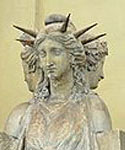
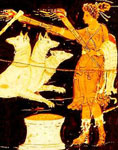

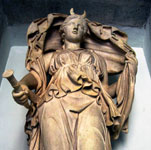
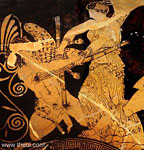
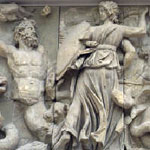



 The flambeau (torch) is said to be one of Hekate’s fundamental attributes, light that illuminates darkness, divine wisdom, divine essence of light. Hekate’s flambeau is used to illuminate souls in their passage between light and darkness, but also to light up the sparkle of life to help it leave darkness. The couple Apollo-Hekate, in many oracular sites (eg. Sybil of Cumae) also talks about the two-faced wisdom light: the Apollonian day light and the inner light of nocturnal Hekate.
The flambeau (torch) is said to be one of Hekate’s fundamental attributes, light that illuminates darkness, divine wisdom, divine essence of light. Hekate’s flambeau is used to illuminate souls in their passage between light and darkness, but also to light up the sparkle of life to help it leave darkness. The couple Apollo-Hekate, in many oracular sites (eg. Sybil of Cumae) also talks about the two-faced wisdom light: the Apollonian day light and the inner light of nocturnal Hekate.


 Seen as representing the waning moon, Hekate reminds us of a woman’s age coinciding with menopause and post-menopause, a time that holds the maid and the mother without carrying obligations belonging to them, but only the gifts. Contrary to what’s commonly thought about the female elderly, this is a life phase characterised by wisdom, introspective ability, but also independence, and creative and sexual power.
Seen as representing the waning moon, Hekate reminds us of a woman’s age coinciding with menopause and post-menopause, a time that holds the maid and the mother without carrying obligations belonging to them, but only the gifts. Contrary to what’s commonly thought about the female elderly, this is a life phase characterised by wisdom, introspective ability, but also independence, and creative and sexual power.
 Heket the midwife, the Goddess frog
Heket the midwife, the Goddess frog
 A rite to Hekate: the time of Menopause
A rite to Hekate: the time of Menopause